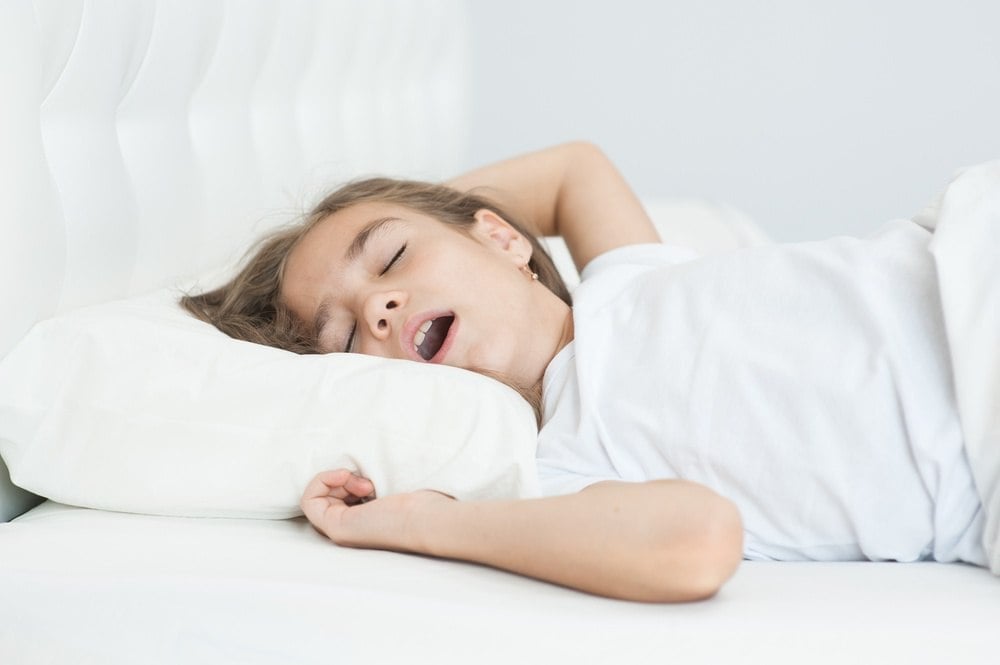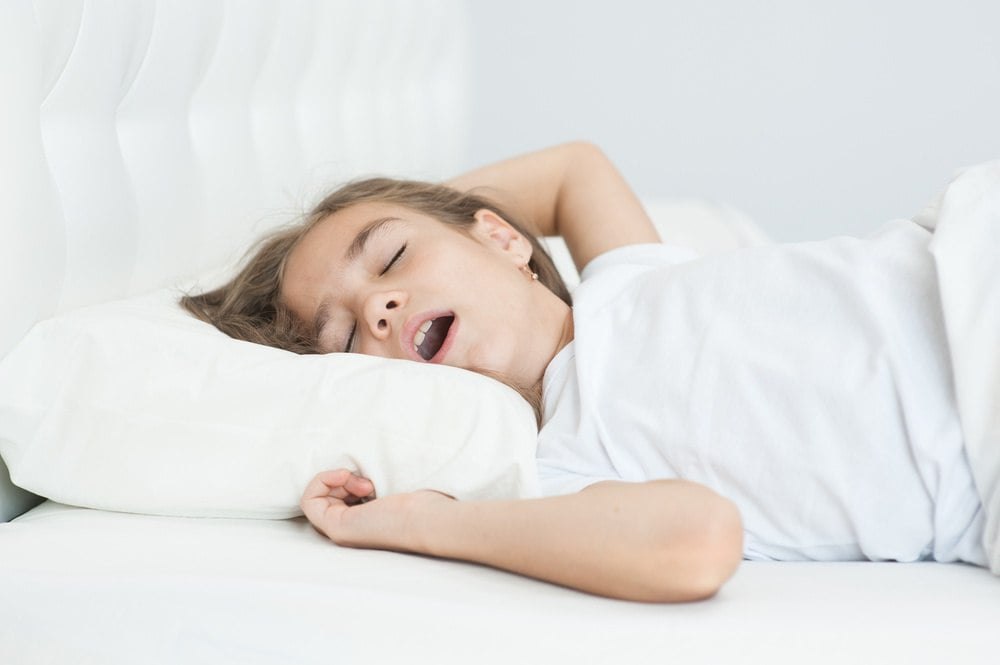Sleep Apnea in Children: Treatment Options
October 12th, 2017 | 5 min. read


While children may not struggle with sleep apnea as much as adults (five percent children vs. 26 percent adults), this condition is still common enough in kids to cause concern for parents.
Children with obstructive sleep apnea (OSA) are usually tired during the day. They often display behavioral problems such as having trouble paying attention since they're not getting the quality sleep they need each night.
Get your child snoring/sleep apnea treated asap. Request an appointment today!
If your child snores regularly, it's more than a nuisance, it can impact their physical, intellectual, and emotional development. Schedule the appointment today at any of our 10 locations near you throughout the Houston, Texas area.
Sleep apnea in children is characterized by pauses in their breathing while they sleep. Generally, this is due to an obstruction in their airways, commonly due to oversized adenoids or tonsils. If your child is dealing with these pauses in their breathing, it can disrupt their sleep. When left untreated, OSA in children can cause high blood pressure, poor growth and heart problems. OSA can also affect cognition and behavior.
Therefore, there are many health benefits of obtaining treatment for your child and the earlier you have your child evaluated, the sooner they can be beneficially treated.
Treatment Options for Sleep Apnea in Children
There are a variety of treatment options for sleep apnea in children including:
Surgical Treatments
There are several types of surgery for sleep apnea in children, including the following.
Tonsillectomy and Adenoidectomy (T&A)
Because the most common cause of sleep apnea in children is enlarged adenoids and tonsils, surgeons perform Tonsillectomy and Adenoidectomy (T&A) as a corrective procedure in the pediatric age group. Removing the tonsils is a procedure known as tonsillectomy. Adenoidectomy is the excision of adenoids. The surgeon generally performs both procedures together; hence the name T&A.
Your child's Houston ENT & Allergies surgeon determines your child's need for the procedure and discuss it with you. The ENT surgeon performs the Tonsilectomy and Adenoidectomy. T & A surgery on an outpatient basis, meaning your child will be able to go home after they have the surgery.
Your child may have to stay overnight for reasons such as:
-
If they have problems with seizures or other chronic diseases.
-
If they aren't drinking well after the procedure.
-
If they have bleeding or other complications after the surgery.
-
If they're younger than three years old.
Before your child goes into surgery, you'll consult with several members of your child's healthcare team. These may include:
- Surgeon: A professional who specializes in the ear, nose and throat.
- Anesthesiologist: The professional in charge of your child's anesthesia. They perform a physical examination and complete medical history of your child to formulate an anesthesia plan for your child. They'll consult with you about this plan and answer any of your questions.
- Day Surgery Nurses: They will get your child prepared for surgery. They're nurses who assist your child's surgeon during surgery.
- Post-Anesthesia Care Unit Nurses: (also recovery room nurses) provide care for your child as they recover from general anesthesia.
Your child receives anesthesia during the surgery. The surgeon removes your child's adenoids and tonsils through their mouth, therefore not having to cut into their skin.
After the surgery, in most cases, your child goes to the recovery room so they can recover from the surgery under the constant supervision of the recovery room nurse. Once your child is doing well and is completely awake, the nurse brings them back to the day surgery area.
You can then take your child home if everything is going well. If your child needs to stay at the hospital overnight, they'll go back to their room or the recovery room where they'll stay for the rest of their time there.
Generally, it takes around seven to 10 days for most children to recover from this surgery. Others may recover faster while some take up to two weeks. T&A has an 82.9 percent overall success rate for uncomplicated pediatric patients, according to a 2006 systematic review.
Bariatric Surgery
Generally, obese patients get this surgery. However, weight loss can actually help those with OSA since obese patients tend to have a lower success rate in OSA treatment with adenotonsillectomy.
Weight loss surgery effects on health issues related to morbid obesity include decreases in incidence or severity of:
-
OSA
-
Hypertension
-
Asthma
-
Diabetes
-
Infertility
-
Heart disease
-
Arthritis
-
Stress incontinence
-
Reflux
-
Pseudotumor cerebri
Medications
Medications for kids with OSA may include:
-
Nasal steroids (Rhinocort, Flonase)
-
Allergy medications (Singulair)
Doctors may use these by themselves or combined.
Behavior Modification
Behavior modification may include avoiding sedatives for three hours before bedtime, avoiding alcohol (adults mostly), changing your child's sleep position to their side (you can use a pillow) and controlling their body weight.
Nasal Strips
Disposable, OTC, adhesive covered nasal strips help decrease your child's nasal airflow resistance. But, nasal strips haven't really been effective in children with sleep apnea.
Nasal Fluticasone
You administer nasal fluticasone every day for six weeks to mitigate the frequency of your child's obstructive events when they have mild-to-moderate OSA caused by adenoid or tonsil hypertrophy.
Continuous Positive Airway Pressure (CPAP)
CPAP, or Continuous Positive Airway Pressure, is a small device that blows air gently through a tube that connects to a mask attached to your child's mouth and nose or nose alone. The device sends air pressure to your child's throat in the back to keep their airway open.
Doctors often use positive airway pressure therapy to treat pediatric OSA. Although doctors recommend CPAP when needed, the compliance downfalls in this age group with using CPAP aren't the greatest.
In children, particularly those with anxiety, developmental delays or behavioral problems, adherence to the CPAP machine may be challenging. Your child could physically or verbally resist your efforts to put the mask on them. Also, your child could develop conditioned anxiety due to the equipment not fitting properly and repetitive association of the sound, sight and sensation of CPAP with physiologic arousal from struggling, mask discomfort or both.
The difficulties doctors have with prescribing CPAP to children are being addressed slowly with tailored treatments and new equipment.
Other Treatment Options
There are other sleep apnea treatment options, including:
Oral Appliances
In some cases, oral appliances can help with pediatric OSA, particularly if your child's facial bone growth is greatly complete. There are several oral (PO) appliances that help bring the tongue and lower jaw forward while your child sleeps which improve OSA. The appliances are costly and require a dentist or other dental professional's help.
These appliances, however, do come with adverse effects like temporomandibular joint dysfunction and jaw pain. If your child is young, they will likely outgrow the appliance and a dental professional will have to either refit the appliance or replace it. Basically, PO appliances don't have a lot of usefulness in pediatric patients.
Soft Palate Repair
Some children have soft palate abnormalities at the back of their throat and mouth that can cause sleep apnea. These abnormalities may include:
-
A stiff soft palate that's larger than normal.
-
The walls of the throat around the soft palate and the soft palate itself collapse easily.
An orthodontist or dentist plays a big role in increasing the airway space, especially the soft palate and other dental procedures that can help with your child's sleep apnea.
Weight Management
Weight management is strongly encouraged for kids with OSA who are obese or overweight and includes exercise, nutritional and behavioral elements. An essential element of weight management is getting adequate sleep.
Dietary Restrictions
Dietary counseling and limited caloric intake are important if your child's obesity complicates their apnea. If your child has significant OSA, they should not eat big meals before bed, especially if they're using a CPAP device which may lead to gastric distention and air swallowing. You'll want to introduce your child to an appropriate diet that will help facilitate weight loss.
Sleep Position
OSA in children is typically worse in the supine sleep position (lying horizontally with the torso and face facing up) when compared to the prone sleep position (lying horizontally with the torso and face facing down. Therefore, you should do your best to ensure your child sleeps in the prone position as much as possible. You can do this by using pillows or sew a pocket in your child’s pajamas (in the shirt) and place a tennis ball in it. This technique while helpful in mild cases of OSA, it’s not that successful in major OSA cases.
The specific treatment for your child's OSA depends on various factors. Your child's doctor tailors the treatment specifically to your child. Be sure to make an appointment to discuss your child's sleep apnea, treatment option, and preference with a Houston ENT doctor.
Dr. Martin is double boarded in Otolaryngology as well as Sleep Medicine and the only otolaryngologist to be board certified in Sleep Medicine in Fort Bend County.

